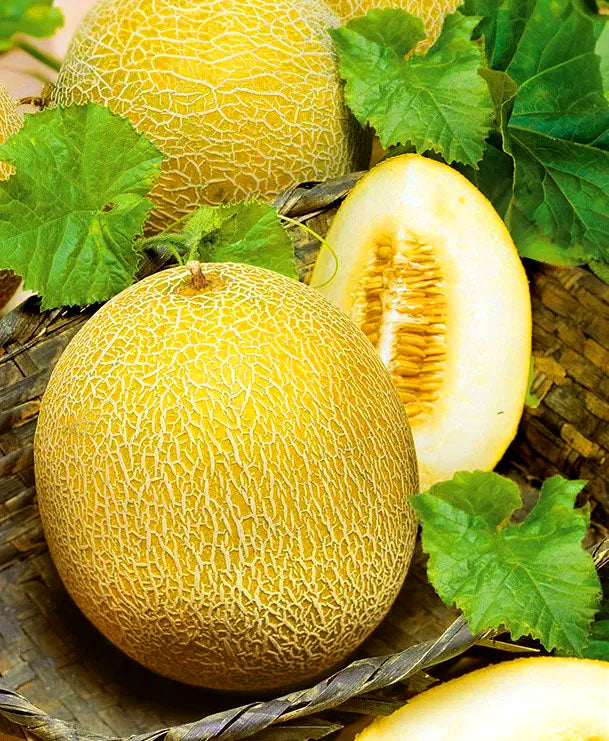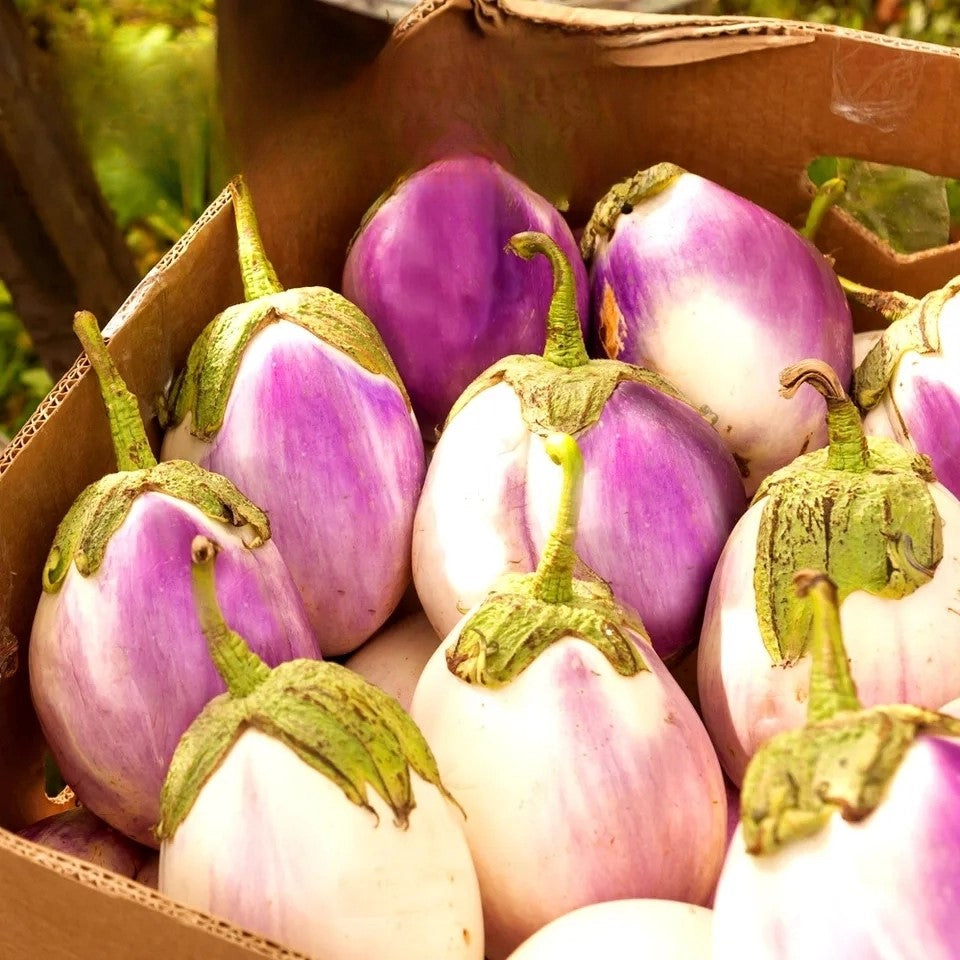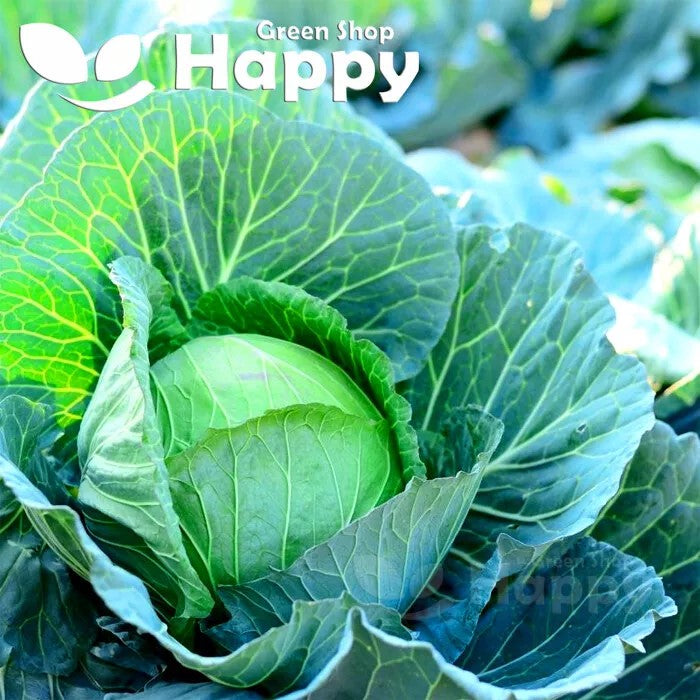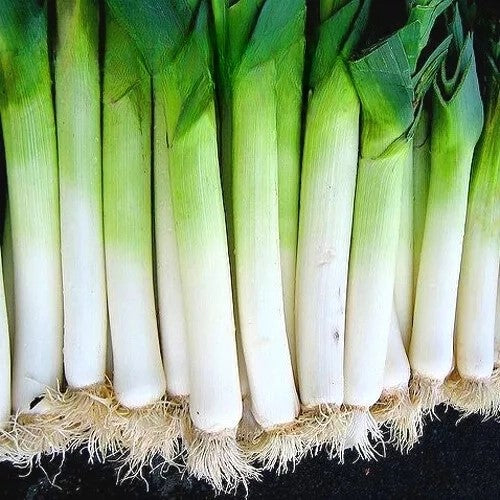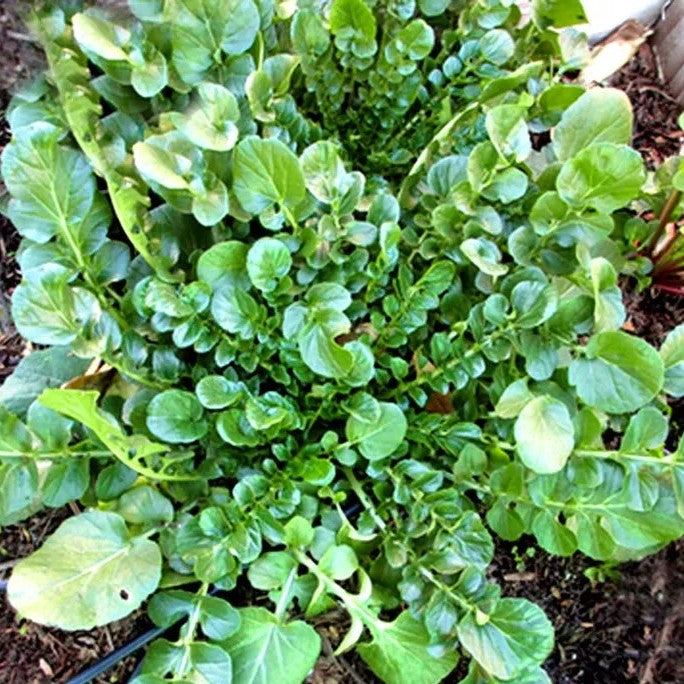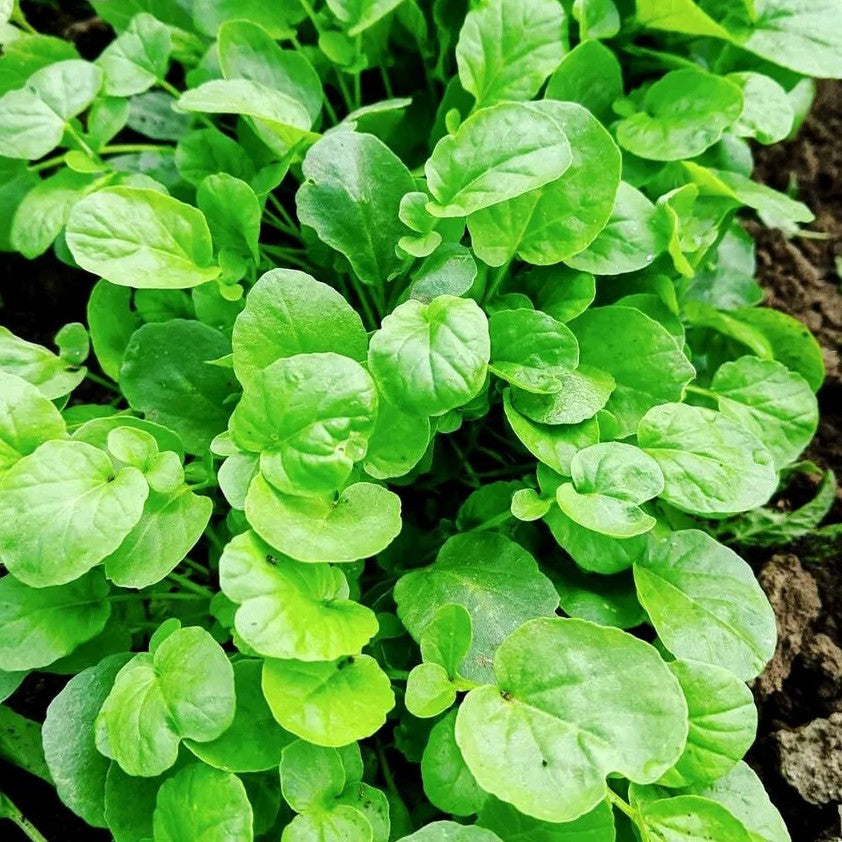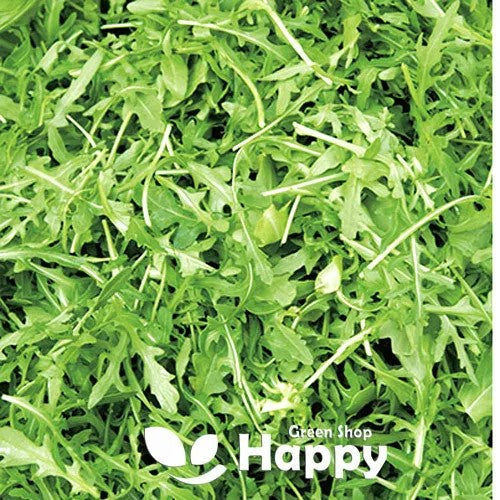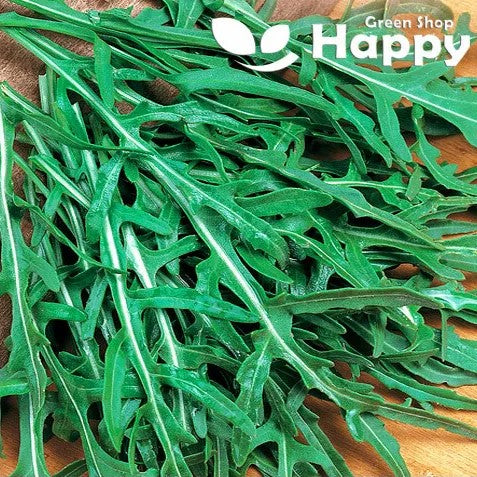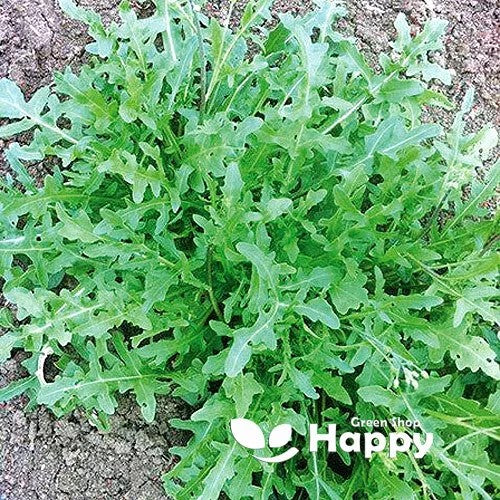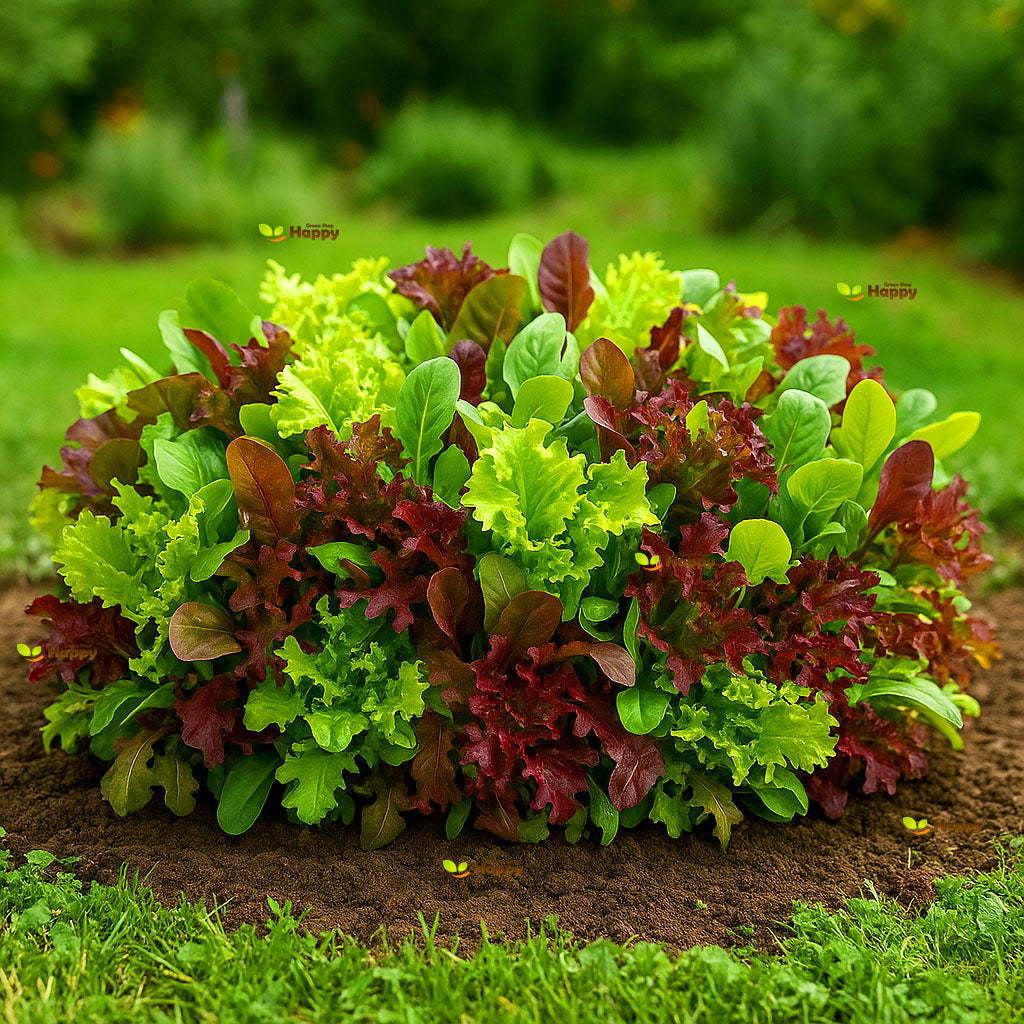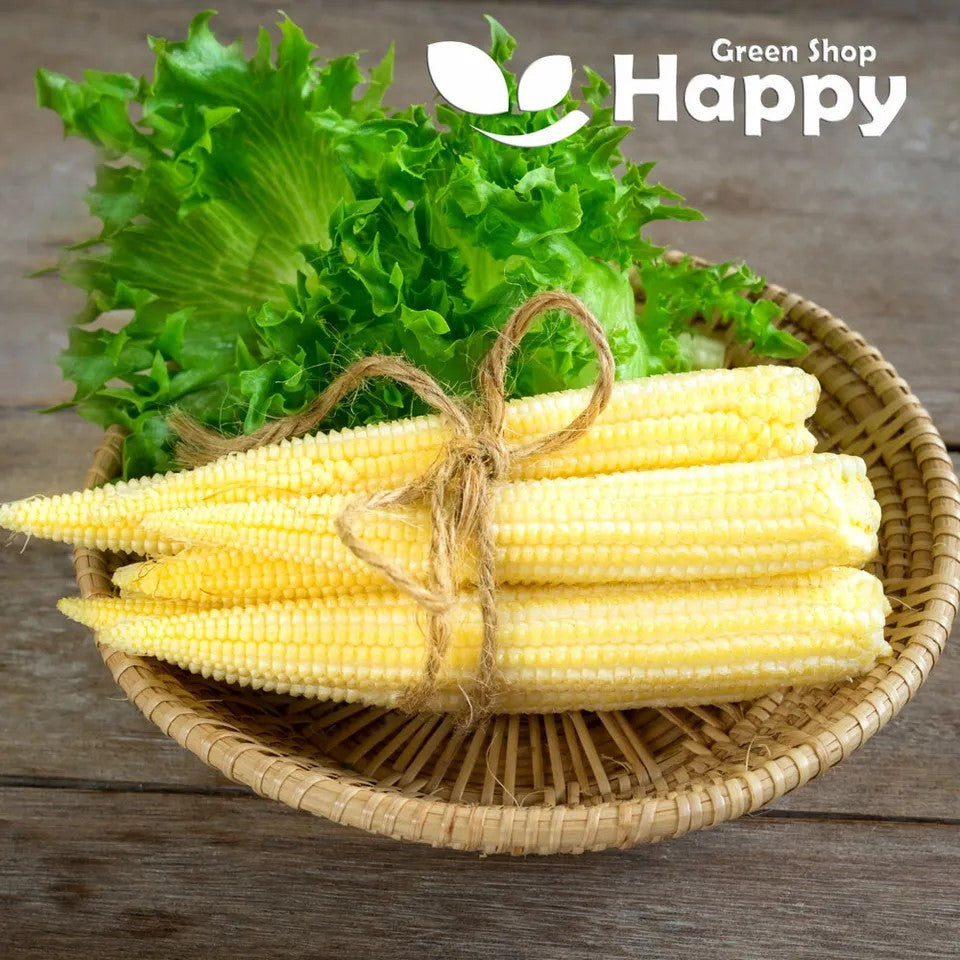Sort by:
1113 products
1113 products
Aubergine 'Rotonda Bianca Sfumata di Rosa' – Seeds (Solanum melongena)
A true Italian heirloom, ‘Rotonda Bianca Sfumata di Rosa’ is one of the most striking and delicious aubergines you can grow. Its fruits are round, creamy-white with beautiful pink to violet shading, making them as decorative as they are tasty. The flesh is tender, mild, and sweet, never bitter, and perfect for grilling, roasting, or adding to Mediterranean dishes. Productive plants produce a generous harvest throughout summer.
How to Grow
-
Sow indoors: January – April, in pots or seed trays, 0.5 cm deep.
-
Germination: 18–25°C; aubergines need steady warmth to sprout.
-
Transplant: Pot on seedlings and harden off before planting outdoors after frost.
-
Spacing: 50–60 cm apart.
-
Position: Full sun, sheltered and warm spot (greenhouse or polytunnel recommended in cooler climates).
Key Features
-
Traditional Italian heirloom aubergine
-
Decorative, round fruits with pink-violet blush
-
Tender flesh with mild, sweet flavor
-
Prolific, long harvest period
-
Ideal for grilling, baking, or Mediterranean cooking
Ideal For
-
Mediterranean cuisine (Parmigiana, Ratatouille, Grilled Aubergine)
-
Greenhouses, polytunnels, or sunny gardens
-
Gardeners seeking unique, colourful crops
Sowing & Harvest
-
Sow: January – April
-
Harvest: July – September
Quick Tip
For best results, pinch out the growing tip once the plant has 5–6 fruits developing. This helps focus energy on ripening for a bigger, tastier harvest.
Aubergine Eggplant ‘Black Beauty’ – 150 Seeds (Solanum melongena)
Description:
Grow classic, glossy eggplants with Aubergine ‘Black Beauty’ (Solanum melongena). This high-yielding variety produces large, dark purple fruits with tender flesh and mild flavor, perfect for grilling, roasting, or sautéing. Ideal for greenhouses, containers, and garden beds, ‘Black Beauty’ is easy to grow from seed and provides a long harvest throughout the summer. A favorite for home gardeners seeking versatile and productive eggplants.
Key Features
-
Large, glossy dark purple fruits
-
Mild, tender flesh suitable for a variety of dishes
-
High-yielding and long-harvesting variety
-
Easy to grow from seed
-
Ideal for greenhouses, containers, and garden beds
Ideal For
-
Kitchen and home vegetable gardens
-
Containers, raised beds, and greenhouse cultivation
-
Culinary use: grilling, roasting, sautéing
-
Home gardeners seeking productive eggplants
Sowing & Growing
-
Sow Indoors: February–April
-
Transplant Outdoors: May–June, after frost
-
Germination: 7–14 days at 20–25°C
-
Spacing: 50–60 cm apart
-
Support: Optional staking for heavy fruits
-
Light: Full sun
-
Soil: Fertile, well-drained, rich in organic matter
Care Tips
-
Water consistently, keeping soil evenly moist
-
Fertilize every 2–3 weeks with balanced fertilizer
-
Mulch to retain moisture and control weeds
-
Harvest when fruits are fully glossy and firm
Autumn Cabbage 'Stonehead' – Seeds (Brassica oleracea)
The Autumn Cabbage 'Stonehead' is a reliable hybrid variety that produces solid, round heads with crisp, tender leaves. Known for its excellent uniformity and resistance to splitting, this cabbage is perfect for autumn harvests and offers a mild, sweet flavor. Its compact growth habit makes it ideal for smaller garden spaces while still delivering generous yields.
How to Grow
-
Sow seeds indoors from February to April or directly outdoors from April.
-
Plant 1 cm deep in trays or modules and transplant when seedlings are strong enough.
-
Space plants 30–40 cm apart in firm, fertile soil with plenty of moisture.
-
Harvest from late summer into autumn as heads mature.
Key Features
-
Hybrid cabbage with solid, round heads
-
Sweet, mild flavor and tender texture
-
Excellent resistance to splitting
-
Compact growth, great for smaller gardens
-
Perfect for cooking, steaming, and coleslaw
Ideal For
-
Autumn kitchen gardens
-
Fresh cooking and storing
-
Gardeners seeking reliable, uniform harvests
Sowing & Harvest
-
Sow: February to April
-
Harvest: August to October
Quick Tip
-
Keep soil consistently moist to encourage dense, firm heads and avoid stress splitting.
Autumn Leek 'October' – Seeds (Allium porrum)
Autumn Leek 'October' is a hardy, slow-growing variety ideal for autumn and winter harvests. Producing long, thick, pale stems with mild, sweet flavor, it is perfect for soups, stews, quiches, and braised dishes.
Reliable and robust, this variety tolerates frost well, making it a staple for late-season vegetable gardens, raised beds, and allotments.
How to Grow
-
Sow indoors: February – March
-
Transplant outdoors: May – June
-
Depth: 1–2 cm
-
Spacing: 15–20 cm between plants, rows 30–40 cm apart
-
Position: Full sun to partial shade
-
Soil: Deep, fertile, well-drained, enriched with compost
-
Watering: Keep soil moist, avoid waterlogging
Key Features
-
Hardy leek variety for autumn and winter harvest
-
Long, thick, pale stems with mild, sweet flavor
-
Excellent for soups, stews, quiches, and braised dishes
-
Frost-tolerant and reliable in cold weather
-
Suitable for home gardens, raised beds, and allotments
Harvest
-
Harvesting period: October – February
-
Pull leeks when stems are thick and firm; can overwinter in the ground with light mulching.
Short Tip
Blanch stems by mounding soil around them in late summer for longer, tender white stems.
Baby Leaf "American Land Cress" – Seeds (Barbarea verna)
American Land Cress is a fast-growing, peppery leafy green ideal for baby leaf salads, sandwiches, and garnishes. Known for its crisp texture and tangy flavor, it adds a fresh, zesty note to spring and summer dishes.
Easy to grow and quick to harvest, this hardy green thrives in both garden beds and containers, making it perfect for continuous salad production.
How to Grow
-
Sow outdoors: March – September
-
Plant spacing: 5–10 cm between seedlings
-
Position: Full sun to partial shade
-
Soil: Fertile, well-drained soil
-
Care: Keep soil moist; thin seedlings to encourage tender growth
Key Features
-
Fast-growing, peppery leafy green for salads and garnishes
-
Tender baby leaves ideal for continuous harvest
-
Hardy and adaptable to garden beds or containers
-
Adds crisp texture and zesty flavor to dishes
-
Easy to cultivate for home gardeners
Harvest
-
Harvesting period: 20–30 days after sowing
-
Pick leaves regularly to encourage new growth and maintain tenderness.
Short Tip
Harvest young leaves for the best flavor and continuously sow every 2–3 weeks for a fresh, ongoing supply.
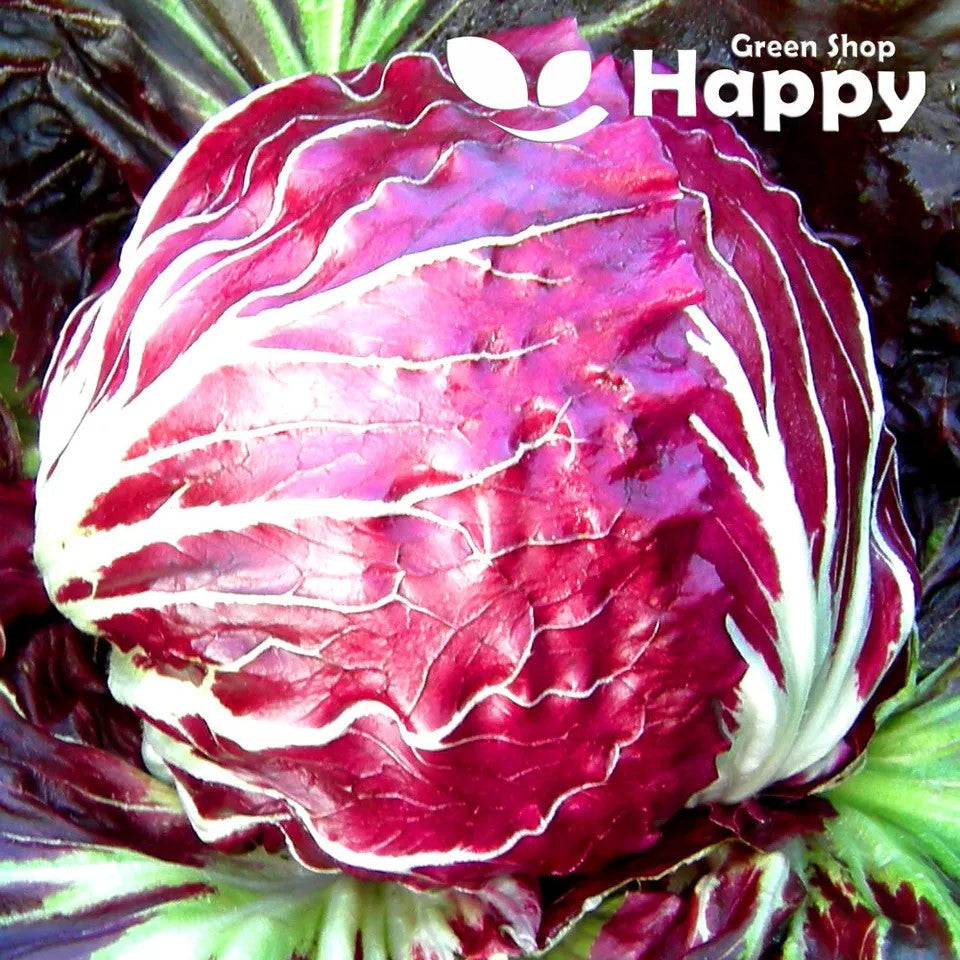
Baby Leaf "Radicchio Palla Rossa 3" - Chicory Endive Crispy Leaf - 1000 seeds
£1.15
Unit price perBaby Leaf "Radicchio Palla Rossa 3" - Chicory Endive Crispy Leaf - 1000 seeds
£1.15
Unit price perBaby Leaf “Radicchio Palla Rossa 3” – Chicory Endive Crispy Leaf – Seeds
Bring vibrant color and crisp flavor to your salads with Radicchio Palla Rossa 3. This Italian variety of chicory forms compact, round heads with striking deep red leaves and white veins, offering a pleasantly bitter yet refreshing taste. Perfect for baby leaf harvesting or grown to full maturity for classic radicchio heads, it adds both flavor and style to the plate.
How to Grow
-
Sow direct outdoors: March – September
-
Sow thinly in rows, 1 cm deep
-
Thin seedlings to 25–30 cm apart for mature heads
-
Prefers fertile, well-drained soil in sun or partial shade
-
Keep soil moist for tender leaves and full flavor
Key Features
-
Traditional Italian radicchio variety
-
Striking red leaves with crisp texture
-
Excellent for baby leaf or mature harvest
-
Adds unique flavor to salads and cooked dishes
-
Reliable, easy to grow crop
Ideal For
-
Fresh mixed salads and baby leaf blends
-
Classic Italian dishes
-
Autumn and winter harvests
Sowing & Harvest
-
Sow: March – September
-
Harvest: June – October (baby leaf) or later for mature heads
Quick Tip
Harvest some leaves young for baby salads and let others mature into full red heads for versatile use in the kitchen.
Baby Leaf Arugula – Wild Wall Rocket – Seeds (Diplotaxis muralis)
Wild Wall Rocket (Diplotaxis muralis) is a vigorous, fast-growing salad green with small, deeply serrated leaves and a strong, peppery flavor. Perfect as a baby leaf crop, it adds a zesty kick to salads, sandwiches, and garnishes. Compared to regular arugula, it has a more intense taste and exceptional regrowth, making it ideal for repeat harvests throughout the season.
How to Grow
-
Sow directly outdoors from March to September in shallow drills (0.5 cm deep).
-
Space rows 15–20 cm apart.
-
For baby leaves, harvest when young; for larger plants, thin seedlings to 10 cm apart.
-
Prefers full sun to partial shade and well-drained soil.
-
Water regularly to prevent leaves from becoming too spicy.
Key Features
-
Strong, peppery flavor – spicier than standard arugula
-
Quick-growing, ready to cut in just 3–5 weeks
-
Continuous regrowth after cutting (cut & come again)
-
Excellent for salads, sandwiches, and garnishes
-
Rich in vitamins A, C, and minerals
Ideal For
-
Baby leaf production
-
Salad mixes and kitchen gardens
-
Gardeners looking for a stronger, wild arugula flavor
Sowing & Harvest
-
Sow: March – September
-
Harvest: April – October (baby leaves in 3–5 weeks)
Quick Tip
-
To enjoy tender leaves, pick regularly before plants flower. Succession sow every 2–3 weeks for a continuous supply.
Baby Leaf Mixture – Oriental Mix – 1000 Seeds
Description:
Enjoy fresh, flavorful greens with the Baby Leaf Mixture – Oriental Mix, a vibrant blend of fast-growing Asian salad leaves. This mix includes a variety of mild to spicy flavors and colorful textures — typically featuring Mizuna, Pak Choi, Tatsoi, Mustard, and other leafy brassicas. Perfect for cut-and-come-again harvests, this easy-to-grow mix thrives in beds, containers, and window boxes, offering a steady supply of nutritious greens all season long.
Key Features
-
Blend of flavorful Asian baby leaf varieties
-
Fast-growing and suitable for cut-and-come-again harvesting
-
Mild to spicy leaves with diverse textures and colors
-
Rich in vitamins and antioxidants
-
Easy to grow indoors or outdoors
Ideal For
-
Salads, stir-fries, and garnishes
-
Kitchen gardens and raised beds
-
Containers, window boxes, and balcony planters
-
Quick, fresh homegrown harvests
Sowing & Growing
-
Sow Indoors/Under Cover: February–September
-
Sow Outdoors: March–October
-
Germination: 5–10 days at 15–20°C
-
Spacing: Broadcast or thin to 10–15 cm apart
-
Harvest: 3–5 weeks after sowing
-
Light: Full sun or partial shade
-
Soil: Fertile, moist, and well-drained
Care Tips
-
Water regularly to keep soil moist
-
Harvest young leaves for best flavor
-
Re-sow every few weeks for a continuous supply
-
Protect from flea beetles with fine mesh if needed
Baby Sweetcorn 'Minigold' – Seeds (Baby Corn)
Grow your own delicious, crunchy baby corn with Baby Sweetcorn 'Minigold'. This early-maturing variety produces tender, sweet mini cobs that are best harvested young, before the kernels swell. Perfect for stir-fries, grilling, steaming, or enjoying as a healthy garden snack. Easy to grow and high-yielding, making it a great addition to both small gardens and larger plots.
How to Grow
. Sow indoors from April to May in pots, 2–3 cm deep
. Sow outdoors from May, once frost has passed and soil is warm
. Plant in blocks for good pollination, spacing 20 cm apart
. Prefers sunny, sheltered spot with fertile, well-drained soil
. Harvest when cobs are 10–12 cm long, before kernels develop
Key Features
. Produces tender, crunchy baby corn
. Sweet flavor with perfect texture
. High-yielding and early variety
. Harvest young for best taste
. Excellent for stir-fries, salads, and steaming
Ideal For
. Healthy garden snacks
. Stir-fries, grilling, and Asian dishes
. Fresh eating straight after harvest
. Home gardeners seeking unique crops
Sowing & Harvest
. Sow: April – May
. Harvest: July – September
Quick Tip
Pick regularly while cobs are small to encourage continuous cropping and maintain their tender sweetness.
Showing 72/1113




